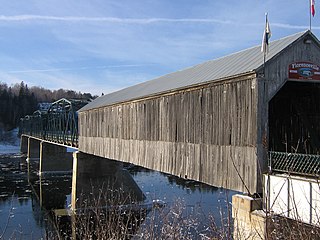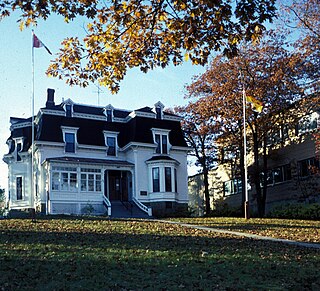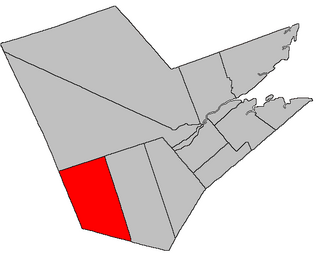
Miramichi ( ) is the largest city in northern New Brunswick, Canada. It is situated at the mouth of the Miramichi River where it enters Miramichi Bay. The Miramichi Valley is the second longest valley in New Brunswick, after the Saint John River Valley.

Florenceville-Bristol is a former town in the northwestern part of Carleton County, New Brunswick, Canada along the Saint John River. It held town status prior to 2023 and is now part of the town of Carleton North.

The Miramichi River is a river located in the east-central part of New Brunswick, Canada. The river drains into Miramichi Bay in the Gulf of St. Lawrence. The name may have been derived from the Montagnais words "Maissimeu Assi", and it is today the namesake of the Miramichi Herald at the Canadian Heraldic Authority.

Route 11 is a provincial highway in northeastern New Brunswick, Canada. The 440-kilometre (270 mi) road runs from Moncton to the Quebec border, near Campbellton, at the Matapédia Bridge, following the province's eastern and northern coastlines.

Chatham is an urban neighbourhood in the city of Miramichi, New Brunswick, Canada.

The Southwest Miramichi River is a river in New Brunswick, Canada.
William Davidson was a Scottish-Canadian lumber merchant, shipbuilder and politician. He was the first permanent European settler on the Miramichi River in New Brunswick.
The Bartibog River is a tributary of the Miramichi River in New Brunswick, Canada.

The Miramichi Valley is a Canadian river valley and region in the east-central part of New Brunswick. It extends along both major branches of the Miramichi River and their tributaries, however it is generally agreed that the much larger Southwest Miramichi River forms the majority of this region as it is more settled than the Northwest Miramichi River.

Doaktown is a Canadian village in Northumberland County, New Brunswick.

Louise Elizabeth Manny was a Canadian folklorist and historian from New Brunswick. She was born in Gilead, Maine but her family moved to New Brunswick when she was three. She grew up on the Miramichi River and there she developed an interest in the local history, of which she wrote and broadcast extensively.

The Hillsborough River Bridge is a bridge crossing the Hillsborough River estuary between Charlottetown and Stratford in Queens County, Prince Edward Island. The current road bridge, built in 1962, replaced a 1905 rail bridge crossing the same span which was known by the same name.
The 1825 Miramichi Fire, or Great Miramichi Fire, or Great Fire of Miramichi, as it came to be known, was a massive forest fire complex that devastated forests and communities throughout much of northern New Brunswick in October 1825. It ranks among the three largest forest fires ever recorded in North America.

Ludlow is a geographic parish in Northumberland County, New Brunswick, Canada.
The Miramichi Folksong Festival, is the oldest folk music festival in Canada. It is held annually in Miramichi, New Brunswick, Canada. It was established by Louise Manny in response to a request from Lord Beaverbrook that she document the traditional songs of his boyhood home. It is the longest continuous event of its kind in Canada and one of the longest in North America. The first festival was held in September 1958 at the Beaverbrook Town Hall and Theatre in Newcastle, New Brunswick. The festival is still held at this location, now in August of each year.

Newcastle is a geographic parish in Northumberland County, New Brunswick, Canada.

Southesk is a geographic parish in Northumberland County, New Brunswick, Canada.
Upper Miramichi is a Canadian rural community in Northumberland and York Counties, New Brunswick.
Route 117 is an East/West provincial highway in the Canadian province of New Brunswick. The road runs from Route 11 intersection in Saint-Louis. The road has a length of approximately 114 kilometres, and services small, otherwise isolated rural communities. In these areas, the highway is often unofficially referred to as "Main Street." The Road is called Loggie Road, Wellington Street, University Avenue, and Airport Road in the city of Miramichi. This Route Mainly follows the Gulf of St. Lawrence in New Brunswick.
Route 118 is a North/South provincial highway in the Canadian province of New Brunswick. The road runs from Route 126 intersection in Miramichi. The road has a length of approximately 40 kilometres, and services small, otherwise isolated rural communities. In these areas, the highway is often unofficially referred to as "Main Street." The road parallels the Miramichi River as well as Route 108 and later Route 8 directly to the North side of the river. The highway starts in Miramichi as Islandview Drive. The Highway starts next to Beaubears Island later passing Barnaby Island and lastly Doctors Island. In Miramichi River Valley, the Highway changes to Colonial Drive and lastly Campbell Road.











